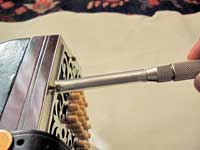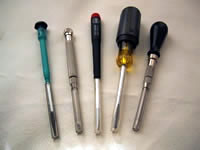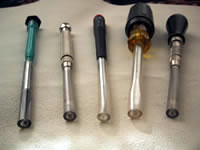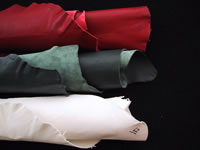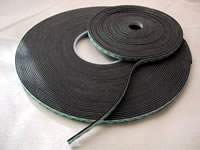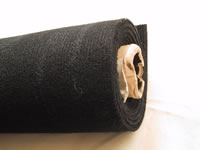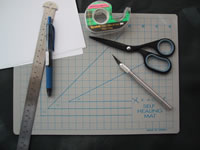Posted 15 February 2002
Baffles for Maccann Duet Concertinas:
Section III. Appendices
Robert Gaskins
15. Appendix: How I Avoided Marring the End-Bolts
Fitting baffles involves removing and replacing the ends of the concertina a
number of times, and hence a lot of unscrewing and screwing the end-bolts.
An improperly-fitting screwdriver will twist or slip, marring the slots
in the end-bolts, and it is very easy for the screwdriver to slip from the
slot, scratching the concertina or worse. It's worth taking precautions to
avoid this, since the end-bolts are not easily replaceable.
The solution is a tip that Steve Dickinson gave me; I've since heard that
he's taught it to many other people. It is to fit a piece of transparent
plastic tubing over the blade of the screwdriver, so that the tubing goes
around the head of the end-bolt. This holds the screwdriver blade accurately
centered in the slot in the end-bolt, so that only a normal level of care and
attention is required.
Many different screwdrivers and bits of tubing will work, but here's my
particular recipe. First, the screwdriver. One wants a short and small
screwdriver, so as not to have too much strength on the end-bolts (finger-tip
pressure is adequate), and one wants a screwdriver that fits the end-bolts
just exactly.
The heads of Wheatstone and Lachenal end-bolts appear to be
generally either 5/32" (4mm) or 3/16"
(4.75mm). Each concertina can have its own matched screwdriver, but in
practise a single screwdriver is convenient. I have experimented with both
4mm and 3/16" screwdrivers, and the 4mm seems to be the better size; the 4mm
blade is large enough for all bolts, and the smaller tubing holds all the bolts
securely.
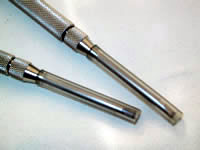
The plastic tubing is chosen to fit snugly over the blade of the screwdriver
and all the way up the shaft to the handle, so that a tube of plastic encases
the entire shaft and blade and protrudes a bit beyond the tip (about 2mm beyond).
Tubing made to either 4mm or 5/32" (3.96875mm) inner-diameter will fit properly.
Tubing comes with a variety of thicknesses of walls, and in a variety of
materials which are stronger or weaker, stretchy or rigid, soft or hard,
and so forth. Tubing of 4mm inner diameter generally comes with walls 1mm
thick, giving an outer diameter of 6mm. Tubing of 5/32" generally comes with
walls 2/32" thick, outer diameter 9/32" (7.14375mm). Either is usable, but
the thicker tubing is stronger. The tubing should
be flexible, and fairly stretchy. In use the end of the tubing is stretched
over the bolt heads and contacted by the screwdriver blade, so in time it
will fray and tear--hence, the stronger the better. The inner diameter of
tubing can vary slightly; if necessary, a wrapping of transparent tape can
be put around the screwdriver blade so that the tubing will not slip or twist.
There is no need to use any adhesive to secure the tubing.
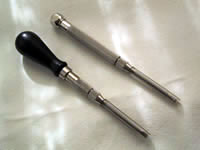
The best screwdriver I have found is made by the L. S. Starrett Company, of
Athol, Massachusetts, a maker of precision tools founded in 1880;
the Starrett screwdriver is available on the web from
Micro-Tools and Micro-Tools Europe, see Suppliers).
They make two models
of what they call their "Pocket Screwdriver" because the blade
(before it has its tubing added) can be reversed
and telescoped into the handle for safe carrying in a pocket. These are nicer
than most small screwdrivers, appropriate for special work. Each model is
made in two sizes (A and B), and the larger B size is just exactly the right
size to fit concertina endbolts. Model #553B is all metal, with a hexagonal
head (not rotating, but rounded for easy turning against the palm); blade
length is 3 inches, over-all length 5 5/8 inches (USD 7.65, GBP 5.40, EUR 8.70).
Model #559B is essentially the same but with a smooth and comfortable wooden
handle, which makes it a bit lighter and larger; blade length is 3 inches,
over-all length 6 inches (USD 12.85, GBP 9.00, EUR 14.60). Both #553B and
#559B use the same replaceable blade, #PT2351B (USD 1.85, GBP 1.30, EUR 2.10).
This blade has a nominal width of 0.15 inches (3.81mm) but it appears to run
just a hair larger, more like 0.1525 inches (3.87mm), so it is very close to
the 4mm size of the bolts. More importantly, the shape of the point of the
Starrett blade is different from that of other small screwdrivers.
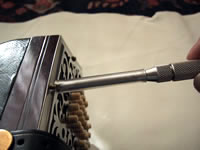
The "jeweler's screwdriver" generally used on concertina end-bolts
is all-metal and four or five inches long; but the blade of a typical jeweler's
screwdriver is too thin, so that it twists in the slot and marks the bolt head,
and very easily skids out of the end of the slot at certain angles. A better
choice would be the sort of screwdriver made for electronics work (such as a
Wiha #26040, or a Moody #2005), which is about the same size, and also has a
smooth cylindrical shaft with no flare at the flattened blade, but which has
a thicker blade. Indeed, the blade on electronics screwdrivers is just a
little TOO thick to fit into the slot of an end-bolt--but that's a problem
easily solved in about five minutes with a fine file. These screwdrivers
can be used, and I have used both kinds, but they lack the ideal point shape
of the Starrett blade.
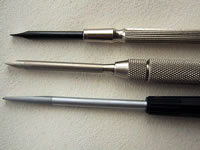
The blade of a screwdriver should fit fully and squarely into the slot of a
bolt, filling the slot from the top and stopping just a hair before bottoming-out.
If the blade bottoms out, so that its leading edge reaches the bottom of the slot
first, holding off the wide sides of the blade so that they lack friction against
the sides of the slot, the tendency to skid out from the end of the slot will
be pronounced . A jeweler's screwdriver has a short point at the end of a
cylindrical shaft, but the point is shaped so that the tip of the blade
remains very narrow for several millimeters--too narrow to fill the slot.
An electronics screwdriver has a very long tapered point at the end of a
cylindrical shaft, with the tip just a bit too wide for an end-bolt--so it
must be filed very carefully, because if it is narrowed uniformly up the
point it also becomes too narrow to fill the slot. But the Starrett Pocket
Screwdrive blade has a short point which widens rapidly; the tip is narrow
enough to fit in an end-bolt slot, but the point widens rapidly enough that
the sides of the blade fill the slot securely before the tip bottoms out.
When viewed under high magnification in actual end-bolt slots, it looks as
though it were designed for this task.
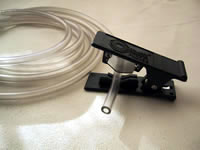
The tubing I used to fit the Starrett screwdriver is McMaster-Carr part
number 5006K17, "High-Strength PVC
Tubing, 5/32" ID, 9/32" OD, 1/16" Wall".
This is sold in units of five feet, at a price of USD 0.33 per foot (GBP 0.23,
EUR 0.38). A length of ten feet would cut up into more than 60 pieces each
50mm long (protruding about 2mm beyond the tip of the blade on the Starrett
screwdriver), which should be a good supply for one screwdriver. I cut both
ends squarely and smoothly (this can be done with a knife, or with a small
cutter manufactured for the purpose, McMaster-Carr part number 8288A51,
USD 6.03, GBP 4.25, EUR 6.85.). Then I pushed the tubing over the screwdriver
blade until it seated against the knurled nut, leaving 2mm proud of the
screwdriver blade tip. The blade enlarges just a bit where it enters the
nut, so it holds the tubing just firmly enough, and a wrapping of
transparent tape (around the blade, inside the tubing) can be added
to prevent slipping.
This may seem like a lot of effort for a screwdriver, but anyone who has used
the tubing trick will testify that it very nearly solves entirely the problem
of slipping. At a minimum, any screwdriver that you are using now can be
significantly improved by just buying a few inches of 4mm plastic tubing
and putting it over the blade. You will still need screwdrivers without the tubing too,
of course, for tasks other than endbolts--this makes a special screwdriver just
for concertina endbolts.
Without this tip from Steve Dickinson, I would surely have done some damage
to my concertinas--with it, I didn't slip off once.
16. Suppliers
(A) Leather
As described above,
there is one obvious supplier for the leather
needed: J. Hewit & Sons. It's hard to describe just how much nicer
their leather is than any alternative I could find. Hewit does a
substantial worldwide business with discerning clients, sells single
skins, has very reasonable pricing, has a comprehensive website, is
extremely easy to deal with, responds promptly and intelligently to
email, and ships by post or by UPS to anywhere in the world with quick
delivery. There really is no reason to buy any other leather for
baffles; this is exactly the right thing.
J. Hewit & Sons Ltd.
Edinburgh
Tanners and Leather Dressers
and Suppliers for all Craft Bookbinding requirements
(By appt to HM the Queen, manufacturers of leather)
web: www.hewit.com
email: sales@hewit.com
Hewit makes and sells leather of many kinds (including sheepskin,
calfskin, and pigskin), but the principal leather of interest for concertinas is
their goatskin. "Goatskin is tougher and more tightly fibered than
sheepskin, has a hard-wearing grain, and, when properly tanned, can
last for centuries. It colors beautifully and has a distinctive texture
identified by ridges and furrows in the grain, and hair pits in groups
all over the surface." "Although Moroccan, the best known goatskin,
was first produced by the Moors, possibly as early as the 11th Century
or before, the use of goatskin in Europe did not become common until
the first half of the 16th Century, in Italy, and was not common in
France until the second half of the 16th Century. It was rarely used
in England before 1600. Since its rise to ascendency, however, it has
been the traditional skin used in fine bookbinding." (From the Hewit website.)
They have more than one kind of goatskin, but the one of interest is Chieftain Goatskin.
Chieftain goat is made from East Indian goatskin, re-tanned in Edinburgh.
These skins are shaved to a thickness of 0.9-1.0mm (2 1/2 oz). Each
skin has a flat cutting area of about 65cm x 55cm (25.5 inches x 21 inches).
It is vegetable-tanned and aniline dyed, and polished to highlight the natural grain.
The surface has no pigment. Chieftain goat is dyed in traditional colors,
suitable for concertina-making.
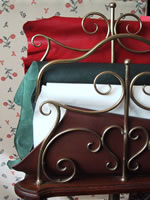
Each individual skin is graded, into grades I, II, or III, with different
pricing. The grades measure how perfectly each skin turned out when treated
in the same way (they are NOT different kinds of leather or different
processes). Basically, grade II is the standard quality skin--the great
bulk of the production turns out to be grade II. Grade II skins have
some minor defects (usually an inch or less in diameter) which can be made to fall in
the waste between concertina baffles. A small percentage of skins happen
to be free
of such marks over larger areas, and these are grade I; there is no need
at all to buy grade I for concertina baffles. (Grade I may not be available
anyway, and it really should be reserved for binding large books where it is
needed.) Grade III skins have fewer and smaller unmarked areas, but would be
completely satisfactory for concertina baffles (I have used both grade II and
grade III skins for my own baffles, and they are equally good for this purpose).
It is always worth asking for
grade III skins because they cost as little as half as much as grade II,
but there aren't many of them--the aim is to produce all grade II or
better. In the processing, the grain of the goatskin can be more or less
pronounced, and this is not entirely controllable. For concertinas, the
skins with "pronounced" grain are good, so that the grain is visible through
the small open areas of fretwork, and Hewit will,
on request, hand-select a "pronounced-grain" skin from those available in
any grade. But this is a very minor refinement, and any skin will make
beautiful baffles.
Prices at 04 January 2002: Grade II: 97.74 GBP/M2 (pounds sterling per square meter).
The average skin (the unit of sale) is 0.46--0.65 sq meters (5.0--7.0 sq feet),
so the price of a grade II skin would be between GBP 44.96
and GBP 63.53 depending on size. Grade III: 48.61 GBP/M2. So the price
of a grade III skin would be between GBP 22.36 and GBP 31.60 depending on size.
NOTE: these prices do not include shipping, and
do not include VAT at 17.5% which will be charged on sales to the UK or the EU (not
on sales exported to the US).
For very light creamy-white leather (literally the color of fresh cream), what
is wanted is Hewit's Alum Tawed Goat. "Alum Tawed Leathers are known for their
archival qualities, phenomenal strength and longevity. We produce the Alum Tawed
Goat in two shades, white and cream. The average size per skin is normally between
0.63-0.74 square meters (6.75-8 square feet), although both larger and smaller
skins are occasionally available. They are supplied to substance of 0.9mm. These
skins will yield a cut approximately 75 x 60cm. Available in grades I and II." (From
the Hewit website.)
The "cream" shade is more appropriate than the "white" for baffles, I judge,
and it looks great with rosewood or ebony ends.
Although this leather looks like the white leather used for valves, it is not the
same--it is stiffer, with very much the same properties as the Chieftain Goat.
Prices at 04 January 2002: 113.33 GBP/M2 (pounds sterling per square meter).
Since the
average skin is a bit larger than Chieftain Goat, the price of a grade II skin
would be between GBP 71.40 and GBP 83.86 depending on size.
NOTE: these prices do not include
shipping, and do not include VAT at 17.5% which will be charged on sales to
the UK or the EU (not on sales exported to the US).
The Hewit web site contains all the information needed for ordering; they accept
credit cards, and ship by post or by UPS to just about anywhere in the world.
Color samples are online, or you can order a set of samples that includes the
Chieftain Goat (in all colors) and Alum-Tawed Goat--what you will order for
the samples is
"Full Leather Pack [Samples] Our Full Leather Pack includes the following:
Sundries Price List, 'Types of Leather' fact sheet, Standard Leather Pattern Card,
Clansman Pattern, Bookcalf Pattern Card, Chieftain Goat Pattern Card,
Repair Calf Pattern Card, Repair Chieftain Pattern Card, and Smooth Goat
Pattern Card. Also included will be a voucher(s) to the value of GBP 10.00,
redeemable on your next order. Price: GBP 10.00."
So to summarize, the correct kind of leather to order is Hewit's "Chieftain
Goat" for colors, or "Alum Tawed Goat" for creamy white, in grade II (or grade
III if available), with pronounced grain. A single skin will make at least two
pairs and up to four pairs of baffles, and will cost around GBP 55 (USD 80, EUR 90)
for Chieftain Goat and around GBP 75 (USD 110, EUR 125) for Alum Tawed Goat.
(B) Double-Sided Foam Tape
Among the hundreds of varieties of double-sided foam tape produced for
industrial uses, the sort that seems to work best to substitute for the
glued-cork standoffs is a specific 3M product,
described as "3M Double Coated Vinyl Foam Tape 4416 Black, 1/16 inch thick, black,
closed cell, vinyl foam carrier with acrylic adhesive and a paper liner; good cushion, conformable,
flexible, weather and solvent resistant with internal foam strength."
It is described on the web at
www.3m.com, product code 4416
This tape comes in many sizes and lengths; I bought 1/4" wide, 36 yards, USD 22.35 per roll.
3M does not deal directly with customers, but sells through distributors.
Fortunately one of their web-based distributors is just superlative:
McMaster-Carr. These folks stock about 350,000 industrial products, all
extremely easy to find through their excellent web catalogue, and they have
outstanding web ordering software and customer service. They ship promptly,
and accurately, and accept credit cards. The McMaster-Carr
part number for this particular 3M tape is 76545A21.
McMaster-Carr Supply Co.
9630 Norwalk Blvd.
Santa Fe Springs, CA 90670-2932
Tel: +1 562 692 5911
web: www.mcmaster.com
This is a GREAT web site; easy to navigate, easy to build an order,
easy to buy, very easy to track orders, accept credit cards, ship UPS,
extremely reliable, a great supplier. These folks have done a particularly
good job of making their 350,000-item catalogue easy to consult over the web,
and their software for building and placing an order is the best I've seen.
Their shipping accuracy is phenomenal (I've ordered hundreds of complex
items, with never one error or omission), and their shipping speed
is equally amazing (I complete an order on their website by 6:00 PM, and it
arrives by standard shipping before 9:00 AM the next morning).
Warning: having a resource like this for tools and materials can lead to
significant expense.
From the site: "McMaster-Carr has extensive experience receiving orders
and shipping directly to customers all over the world. We can ship most
items the same day that you place an order, via fax, telephone, e-mail,
postal service or at our secure web site. Typically, DHL and other couriers
can clear the goods through customs and deliver to your door in 3 days."
E-mail:
elm.export@mcmaster.com
Fax: +1 630 834 9427
Phone: +1 630 834 9600
Spanish Line: +1 630 833 7100
Ani Williams, McMaster-Carr Supply Co., Export Manager
So the best double-sided tape for standoffs that I could find is
3M type 4416, "closed-cell PVC foam with acrylic adhesive," color black,
thickness 1/16" (62.5 mils), size 1/4" wide x 36 yards long, McMaster-Carr
part number 76545A21, cost at 04 January 2002 USD 22.35 per single roll
(GBP 15, EUR 24).
(C) Acoustical Fabric
The market in acoustical fabrics is anything but transparent, with secretive
manufacturers dealing through long chains of distributors and dealers with
arcane restrictions and exclusivities. The internet has made little progress,
so there may be many good materials that I don't know about.
The best fabric that I found is manufactured by JM Lynne Co., Ronkonkoma,
New York, a unit of the giant Steelcase contract furnishings group. They
are just barely on the web with a brochure located at
www.jmlynne.com. They only want to sell
through traditional channels, so the problem reduces to finding a good
retailer of their fabric on the web.
The best source that I found for the acoustical fabric is
Netwell Noise Control
Netwell Marketing, Inc.
3001 Harbor Lane
Minneapolis, MN 55447
Email:
info@controlnoise.com
Phone: +1-800-638-9355
Fax: +1-888-809-7251
web: www.controlnoise.com
These people are not accomplished in web transactions--there is no way to
order online. So it is necessary to send in an email inquiry and then order
by email. On the other hand, once this inconvenience is past, they do accept
credit cards, they do ship by UPS, and they have shipped to me both in the US
and the UK so they have no problem with international orders. I experimented
with several suppliers, and these are the most responsive and most reliable.
On their website, the product is called "Silence" and is presented primarily
as a wallcovering. There is an online color chart of the 24 colors; I have tried
#9620 Black and #9601 Ivory, and either is fine--the color makes no difference,
since it will be backed either with leather or with a grille-cloth fabric.
They are very willing to sell a single yard (36" x 54") at a cost (as of 04 January
2002) of USD 22.50 (GBP 15.85, EUR 25.60) plus shipping.
(D) Digital Sound Level Meter
A whole industry has arisen in sound level meters, apparently the creature
of industrial health and environmental laws which set standards for noise
exposure, compliance with which must be measured and documented regularly.
The meters used for this purpose meet a lot of legal requirements and are
good for expert witnesses, but they are by and large too expensive--around
USD 600 or more, which was much more than I wanted to pay.
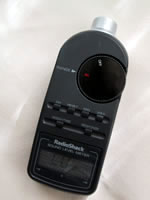
RadioShack (a US company which has in the past had international stores under
the name "Tandy RadioShack" but which has now retreated to the US) has for
many years sold an inexpensive sound level meter, originally analog but now
digital. These meters have been used by audiophiles for all kinds of
measurements, often in conjunction with tapes or CDs which have pre-recorded
tones. The traffic on Google's "Groups" newsgroup archive contains lots of
good things about this unit, about the consistency of measurements from a
single meter and among multiple examples of the type. This has apparently
led to its being the "standard" for low-end amateur audiophile measuring,
since the results can be compared to measurements made by others.
The sound level meter is available on the web at
www.radioshack.com
--just search the site for "sound level meter".
The unit I used is described on the site as follows:
Digital-Display Sound-Level Meter
USD 59.99 Reg. Price
Brand: RadioShack
Cat.#: 33-2055
Model: 33-2055
Provides precise readings when you fine tune audio response of a stereo, PA
or home theater system in combination with an equalizer. Reads 50 to 126dB
SPL, and has "A" or "C" weightings. Carry case. Requires 9V battery.
This unit is about the size of a large eyeglasses case, and it will handle
the full range of sound levels made by concertinas. The complete instruction book
is reproduced on the web. The web information was checked on 04 January 2002.
For people in the US, it can be ordered directly from the website, or by
telephone to RadioShack's 800 number, and it is stocked by most of the stores
(because it is a big seller, according to the clerk who sold me my units);
the nearest store can be found through a directly on the website. With
over 7,000 stores in the US, RadioShack estimates that 94% of all Americans
live or work within five minutes of a RadioShack store or dealer.
Unfortunately, RadioShack has been going through a process of closing all
its international stores and websites, intending to license the name to
others outside the US. As part of this change, they will ship from their
US website only to US addresses. The standard response to this sort of
problem is to find an address in the US to receive the package and re-ship
it.
(E) Screwdrivers for End-Bolts
The best screwdriver that I found for concertina end-bolts (see
above for
details) is from the L.S. Starrett Company, on the web at
www.starrett.com.
Starrett has its entire catalog on the web with substantial technical
information, and will accept direct orders of less than USD 50.00, but
does not post prices and is not really in the business of direct sales.
A Starrett web distributor (which also carries many other useful tools) is
Micro-Tools, at www.micro-tools.com.
This group has a US site, in
California, and a European site, in Germany (same web address, then
select the European store). Both locations carry the #553B, #559B,
and #PT2351B items, and Micro-Tool uses the Starrett part numbers.
I have ordered Starrett #553B and #559B screwdrivers from both the
California and European locations, with prompt and accurate attention
to web orders. They accept credit cards, ship immediately, and offer
a choice of shipping methods.
First choice is model #553B, "Pocket Screwdriver", all metal with a hexagonal
head, blade length is 3 inches, over-all length 5 5/8 inches, USD 7.65,
GBP 5.40, EUR 8.70. A very similar screwdriver with a wooden handle is
model #559B, "Pocket Screwdriver with Wooden Handle", blade length 3
inches, over-all length 6 inches, USD 12.85, GBP 9.00, EUR 14.60.
Both #553B and #559B use the same replaceable blade, #PT2351B (USD 1.85,
GBP 1.30, EUR 2.10). Prices current at Micro-Tool as of 04 January 2002.
The tubing I used to fit the Starrett screwdriver is McMaster-Carr part
number 5006K17, "High-Strength PVC Tubing, 5/32" ID, 9/32" OD, 1/16" Wall".
This is sold in units of five feet, at a price of USD 0.33 per foot (GBP 0.23,
EUR 0.38). A length of ten feet would cut up into more than 60 pieces each
50mm long (protruding about 2mm beyond the tip of the blade on the Starrett
screwdriver), which should be a good supply for one screwdriver. I cut both
ends squarely and smoothly (this can be done with a knife, or with a small
cutter manufactured for the purpose, McMaster-Carr part number 8288A51,
USD 6.03, GBP 4.25, EUR 6.85.). See above for
details of how to order from McMaster-Carr.
(F) Other Tools Needed
craft knife and blade
cutting mat
metal rule
scissors
paper
ballpoint pen
cellophane tape
17. Another Material That Did NOT Work
Just to save other people some time, I can record another material that
did NOT seem to work--at least the way I used it.
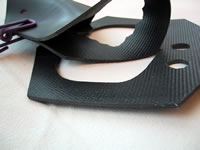
As I explored various acoustical materials, I was interested by
"sound barrier" material--this is a sheet plastic material, made with
heavy minerals incorporated into it so that it is (a) very heavy, about
one pound per square foot, and (b) limp, so as not to transmit vibration.
It is thin (about 1/10" thick) despite being so heavy. Netwell sells it
under the name "dB-Bloc" and there are many other suppliers. I had the
idea, evidently mistaken, that this material when attached to parts of
a concertina would "damp" vibrations and reduce the sound. I bought a
fair amount of this material, and experimented with making baffles out
of it (patterned after the leather ones), both one and two thicknesses,
securely fastened to the fretwork with double-sided tape; to my surprise
the reduction in sound measured exactly the same as when leather was
fitted as described above. I also tried attaching single and multiple
layers of dB-Bloc with full-contact double-sided tape to the inside
surface of the reed-pan, toward the bellows, supposedly to "damp" the
reed-pan; this measured no effect whatsoever.
The sound-barrier material is, with its greater mass, more like the
thin wood reported in old baffles, and, with its flexibility, somewhat
like old cork baffles--so it would seem to unite and "improve upon"
the best properties of both wood and cork. The fact that it has exactly
the same measured effect as leather leads me to suspect that wood or
cork baffles would have no more effect. There was no functional advantage
to the dB-Bloc material, while on the negative side it made the concertina heavier
and lacked the beauty of leather.
18. Chris Timson's Newsgroup Posting on Baffles
Below is Chris Timson's often-reprinted
posting to the squeezebox news group on the topic of how he makes
baffles for his instruments. This are the ideas that I started from,
and which turned out to be a very sound approach.
(Note that since this message was posted, Chris Timson has stopped using
the email address shown; he can now be reached through the
queries page on his
Concertina FAQ website.)
From: Chris Timson <chris@harbour.demon.co.uk>
Subject: Chris & DoN! Tell Us About Baffles! (long)
Date: 1998/05/15
Message-ID: <9a9wzBAFq+W1EALi@harbour.demon.co.uk>
Newsgroups: rec.music.makers.squeezebox
Marc G. Lamb <mglamb@his.com> writes
> Personally, I would strongly caution you
> against performing any 'customization' or alterations
> on a Jeffries.
This is why I like my approach to fitting baffles - using
double-sided tape means the baffles can be fully removed
without a sign of their presence being left. And yes, I
agree that I wouldn't get a Jeffries for song
accompaniment (my own treble is a modern Wheatstone,
metal ended but with surprising sweetness of tone). ...
Here are some instructions for fitting baffles I wrote out
a couple of months ago at the request of somebody who
offered me some C & S back issues for them - this is
why they read as being addressed to a specific person. I
now present them free to the world!
First you need some leather. I have always bought the
leather I need directly from Colin and didn't know what
grade I should use, so I have just phoned him up and
asked. He says you need reasonably stiff sheepskin
(typically as used by organ builders). He also says that
such leather can be dificult to buy in the sort of
quantity you need (which is not much, being basically
twice the area of cross section of your Aeola) and you
may be asked to buy say 2 or 3 metres of it, and it's
not cheap. ...
For tools, all you need is a good, sharp modelling knife
(it must be really sharp because you don't want flecks of
leather getting into the reeds. I don't know if you have
the brand over there, but I always use an Olfa knife which
allows you to snap off the end of the blade when it's
worn, exposing the next sharp edge) and a pair of scissors
for cutting out paper templates. When Colin cut the
baffles he basically did it by eye, but I am not so
skilled, so what I did was to cut paper templates to fit
inside the concertina and then use those as guides when
marking out the leather for cutting. You will also need a
marker pen and some good quality double sided tape. So,
here we go:
1) Dismantle one end of the concertina as described in the
concertina FAQ (leaving the reed pan in place as we are
not interested in it). Put everything on one side except
the end plate of the concertina, this is the only bit we
are interested in.
2) Using scissors and paper cut out a shape that will fit
inside the end. Since you have an Aeola I guess that means
it will be octagonal. Then cut a hole in the paper for the
buttons to fit through when the instrument is reassembled.
Try putting the end plate back onto the action and trim
bits off the paper until everything fits to your
satisfaction.
Guiding principle
~~~~~~~~~~~~~~~~~
The baffle fits inside the end plate, through which air
is drawn when the concertina is played. If you make the
baffles a nice, tight, snug fit you will find that your
concertina will no longer play as the ends will now be
airtight.Therefore don't be exact, leave some space
especially around the button area for air to get through.
3) Once you have the template as you want it then place
the template on the underside of the leather and draw
around it with a marker pen. For appearances sake you
want to have the leather so that the shiny side will be
facing outwards when you reassemble the instrument. Then
cut out the leather with the sharp knife.
4) Cut yourself lots of small bits of double-sided tape
and stick them all over the inside of the end plate,
between the fretwork and at various places around the
edges. If you use a thick tape this is all the better as
it helps let the air through. You will need quite a lot
as only a few will permit the leather to move and possibly
buzz. Strip off the tape covering, position the leather in
place and stick firmly down (note that if you subsequently
decide to remove the baffles you can use lighter fuel to
remove any left over adhesive quite safely).
5) Reassemble the concertina. Try playing the concertina
at this point. You should hear a clear difference between
the two ends. The baffled end should be a bit quieter and
significantly sweeter than the unbaffled end. If the
concertina is stiffer to open when playing a note on the
baffled end than the unbaffled end then you may need to
trim a little more leather off the baffle.
6) Do the whole thing again for the other end. You may be
able to re-use your tempate, but you will probably find
that the shape of the button area is different enough
that you won't be able to.
And there we are. The beauty of this technique is that
you change nothing permanently. If you subsequently resell
the instrument and the new buyer doesn't like baffles
(it's normally only singers like us who think they're
great) then just take them out. It took me about three or
four hours per instrument, but somebody with fewer thumbs
than me might be able to do it quicker.
Chris
--

